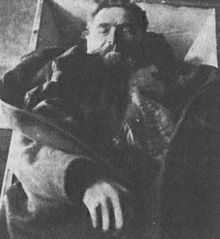Karl Denke
| Karl Denke | |
|---|---|
 Only known photograph of Karl Denke, after his suicide | |
| Born |
August 12, 1870 Oberkunzendorf, Münsterberg, Silesia, Kingdom of Prussia (now Ziębice, Poland) |
| Died | December 22, 1924 (aged 54) |
Cause of death | Suicide |
| Motive | cannibalism |
| Killings | |
| Victims | At least 42 |
Span of killings | 21 February 1903–20 April 1924 |
| Country | Germany (area now part of Poland) |
Date apprehended | 22 December 1924 |
Karl Denke (August 12, 1870 – December 22, 1924) was a serial killer from Germany.
Denke was born in Münsterberg, Silesia in the Kingdom of Prussia (now Ziębice in Poland).[1] At the age of 12 he ran away from home; little else is known about his early life. However, in adulthood he worked as an organ player at the local church and was well-liked in his community.
On December 20, 1924, Denke was arrested after attacking a man at his house with an axe. Police searched Denke's home and found human flesh in huge jars of curing salts. A ledger contained the details of at least 42 people whom Denke had murdered and cannibalized between 1914 and 1918.[2][3] It is thought he even sold the flesh of his victims at the Breslau (today's Wrocław) market as pork.[4]
The days after his arrest, Denke hung himself in his cell.
References
- ↑ "Centipede: Nice enough to eat; Cannibals of the 20th century". The Guardian (in English). May 20, 1993. p. 12.
- ↑ Corke, Jonathan (December 7, 2003). "Cannibal's victim in cold packs; Exclusive pleased to meat you". Daily Star (in English). p. 21.
- ↑ "Cannibalism: Hard act to swallow; What drives some people to eat others? We examine the body of evidence". The Straits Times (in English) (Singapore). December 14, 2003.
- ↑ Robbins, Martin (September 8, 2010). "What does human meat taste like?". Guardian Unlimited (in English).
Bibliography
- Matthias Blazek: Karl Denke, in: Carl Großmann und Friedrich Schumann – Zwei Serienmörder in den zwanziger Jahren, ibidem: Stuttgart 2009, p. 133 f. ISBN 978-3-8382-0027-9
External links
- Short biography, other short articles: and
- original pictures taken in 1925 were found